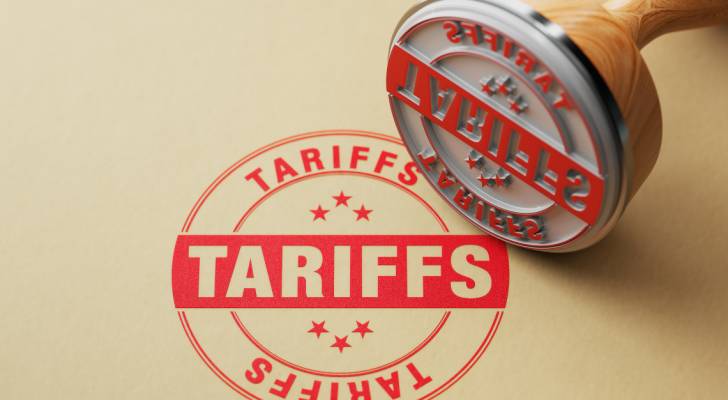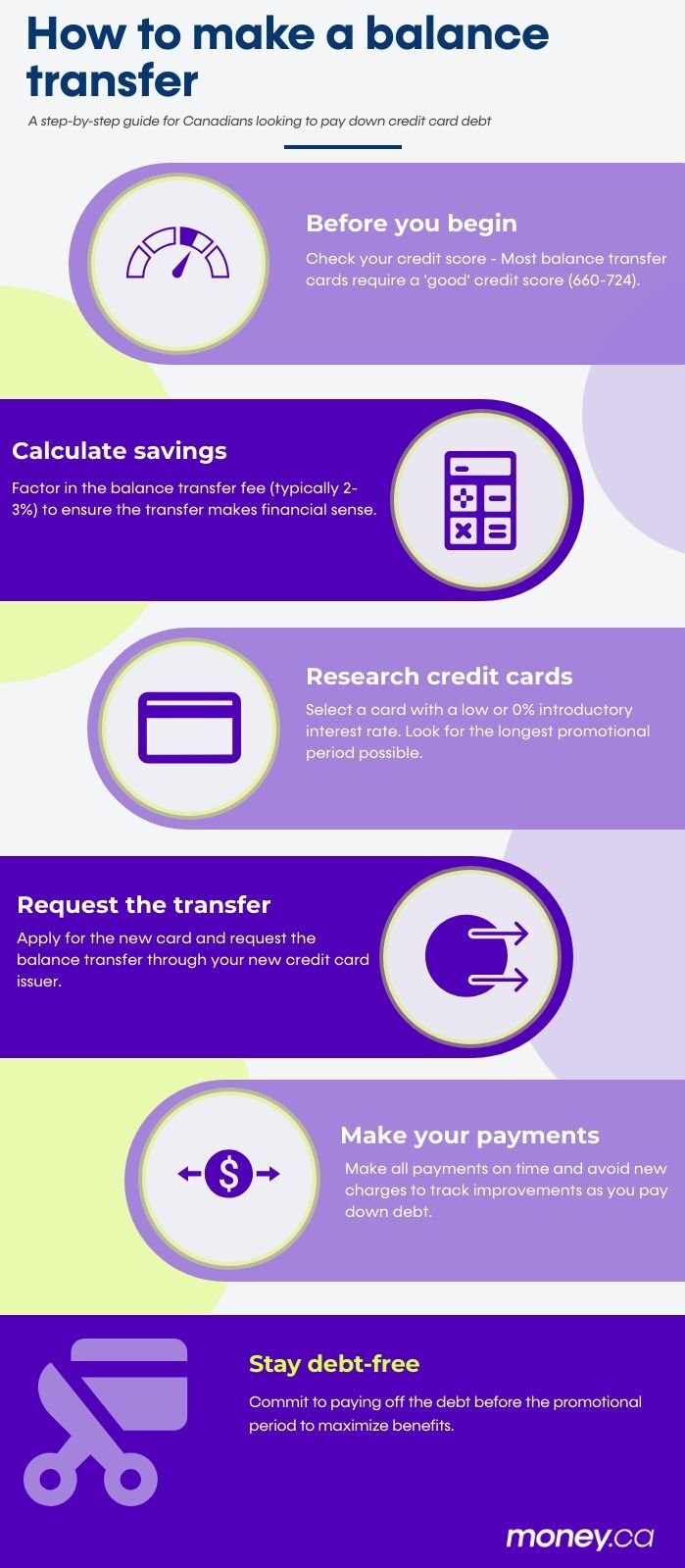
In the wake of Trump’s sweeping tariff policies (and the ensuing political chaos), Canadian households are feeling the economic squeeze. With Canada bearing some of the brunt of U.S. trade actions, many Canadians are seeking financial relief.
Balance transfer credit cards may offer a strategic option for those struggling with mounting debt during these uncertain times, allowing them to pay down balances with lower monthly payments and a reduced (or eliminated) interest rate.
Trump tariffs are straining Canadians’ finances
The Trump administration’s aggressive trade policies have hit Canada particularly hard. Recent economic analysis shows that Canada has borne the brunt of U.S. tariff damage, with the Canadian economy projected to be 2.1% smaller in real terms due to U.S. tariffs and Canadian retaliatory measures according to experts at Yale University’s Budget Lab.
The Bank of Canada’s analysis also anticipates significant financial disruption, with the tariffs will cause a one-time permanent increase in price levels due to retaliatory tariffs being passed on to consumers over time.
And while there’s currently a “pause,” the effective tariff rate for Canadian goods stands at 25%.
READ MORE: Canadian consumers shift spending in response to U.S. tariffs
Tariffs are likely to have a significant impact on Canadian households
These tariffs aren’t just abstract economic policy — they directly impact Canadian households. The April 2, 2025 U.S. tariff announcement alone constituted an increase in the average effective tariff rate of 11.5 percentage points, with comprehensive tariffs raising consumer prices by 2.3% in the short term.
And passing costs on to the consumer is likely to hit Canadians hard. The Tax Foundation estimates that these tariffs will reduce after-tax income by an average of 1.5% and amount to an average tax increase of more than $1,500 per household in 2025.
For the average Canadian consumer, already struggling with high interest rates and inflation, tariffs represent another financial burden during challenging economic times.
The Canadian debt landscape in 2025
Canadian households are entering this period of trade uncertainty with already precarious financial positions. Total consumer debt in Canada hit a historic high of $2.5 trillion in late 2024, with outstanding balances growing 4.5% year-over-year, according to TransUnion.
Credit card balances have reached a new milestone of $124.7 billion, a 9.2% increase, while delinquency rates continue to rise. The cost of servicing this debt has reached historically high levels, with interest payments alone accounting for 9.3% of disposable income — the highest level since at least 1990.
The household debt service ratio, while decreasing slightly to 14.35% in late 2024, remains alarmingly high compared to historical standards. For many Canadians, these debt obligations combined with rising costs due to tariffs create a perfect financial storm.
Does a balance transfer credit card make sense right now?
In challenging financial times paying down debt is critical. A balance transfer credit card might be the financial tool you need right now—think of it as a reset button for your debt situation.
What exactly is a balance transfer credit card?
A balance transfer credit card is like a financial lifeline. It’s designed to help you consolidate high-interest credit card debt onto a new card with a lower interest rate, giving you breathing room to pay off your balance. These cards typically offer a promotional period with dramatically reduced interest rates — sometimes as low as 0% — for a specific timeframe, usually between six to 12 months.
Why make a balance transfer?
With Trump’s tariffs adding pressure to household budgets, balance transfer cards offer several compelling benefits to Canadians struggling with debt:
- Stop throwing money away on interest: With regular credit card interest rates hovering around 21% in Canada, your debt can quickly spiral out of control. Every dollar you pay in interest is money that could be better used elsewhere in your budget. A balance transfer card with a low promotional rate means more of your payment goes toward reducing your actual debt.
- Simplify your finances: Juggling multiple credit card payments with different due dates is not only stressful but increases the risk of missed payments. Consolidating your debts onto a single card simplifies your financial life and makes budgeting more straightforward. One payment, one due date, one interest rate to track.
- Create a clear path to debt-free: A balance transfer card isn’t just about saving on interest — it’s about creating a structured path to become debt-free. The defined promotional period gives you a clear deadline and motivates you to pay down your debt before the regular interest rate kicks in.
How does the balance transfer process work?

A balance transfer involves moving debt from one credit card to another that offers a lower interest rate. This strategy allows you to pay off your balance more quickly while paying less interest.
The process works like this:
- Apply for a balance transfer credit card offering a low introductory rate
- Transfer your existing high-interest balances to the new card
- Pay down the balance during the promotional period
Most balance transfers involve a one-time fee, typically 2 to 3% of the transferred amount. While this fee adds to your total debt, the savings from lower interest rates often outweigh this cost in the short term.
READ MORE: Best low interest credit cards
Real-world balance transfer example
Meet John, a 34-year-old from Toronto, with $5,000 in credit card debt after some unexpected home repairs and a period of reduced hours at work. His existing credit card charged a steep 21.99% APR, and he was making minimum payments of $150 monthly — barely making a dent in the balance.
John took advantage of a great welcome bonus and applied for the MBNA True Line® Mastercard®, which offered 0% APR on balance transfers for 11 months with a 3% transfer fee.
Here’s how the numbers worked out:
- Original debt: $5,000 at 21.99% APR
- Balance transfer fee: $150
- New starting balance: $5,150
- Promotional period: 11 months at 0% interest
- Rate after promotion: 17.99% APR
With his old credit card and $150 minimum payment, John would have spent $850 on interest during the 11 months of 0% APR with his new card. Additionally, it would take an estimated 29 months to repay the total debt.
With John’s new balance transfer strategy:
- His monthly payment needed to clear debt during promo period: $469 ($5,150 ÷ 11 months)
- Total cost during promo period: $5,150 (principal + transfer fee)
- Interest savings: $850 during the promotional period alone
Of course, the $469 payment is three times the size of his previous payment. But this strategy allowed him to repay his full balance in just 11 months. To do this, John made a few lifestyle changes to make the $469 monthly payments:
- He temporarily reduced his dining out expenses
- Paused non-essential subscriptions
- Took on a few freelance projects for extra income
By the end of the 11-month promotional period, John completely paid off his debt, saving approximately $850 in interest compared to his original card, even after accounting for the $150 transfer fee.
Potential drawbacks of balance transfer credit cards
While balance transfers can provide relief, they aren’t without risks, especially during economically uncertain times:
- Not built for new purchases: Transfer credit cards are designed for repaying debt. And while you can still use your card to make purchases, the interest rate on those charges typically isn’t great and can quickly lead to more debt.
- Potentially limited long-term value: Balance transfer cards generally offer promotional rates for six to 12 months. After this period, interest rates typically jump to standard levels, often between 15 to 25%.
- Transfer fees and limitations: Most balance transfer cards charge 1% to 3% of the transferred balance. While this fee is often worth paying given the interest savings, it does increase your total debt load at a time when you’re trying to reduce what you owe.
Balance transfer alternatives
Given the economic uncertainty from Trump’s tariffs, balance transfers may not be the best solution for everyone. Alternative options include:
- Personal loans
- Lines of credit
- Credit counseling
Is a balance transfer right for you?
In these challenging economic times with Trump’s tariffs adding pressure to Canadian households, balance transfer credit cards can offer valuable short-term relief. If you’re carrying high-interest credit card debt and have a solid plan to pay it down within the promotional period, a balance transfer card can be an excellent financial strategy.
A balance transfer only works if you’re going to be diligent about paying off the outstanding credit card debt. The numbers don’t lie. You could save thousands in interest by transferring your balance and committing to an aggressive payment schedule during the promotional period.
However, balance transfer cards only really work if you are willing to put the effort in. That means ensuring you can realistically pay off the balance during the promotional period, be disciplined enough to avoid new, non-essential purchases and have a good credit score to qualify for the best offers.
WHAT’S NEXT: Balance transfer vs. personal loan: Which option is best for you?
Sources
1. Yale University: The fiscal, economic and distributional effects of all U.S. tariffs enacted through April 2
2. Bank of Canada: Monetary Policy Report—January 2025—In focus
3. TransUnion: Canadian Consumer Debt Continues to Grow Despite Macroeconomic Relief (February 19, 2025)
4. Statistics Canada: National balance sheet and financial flow accounts, fourth quarter 2024 (March 15, 2025)
5. Tax Foundation: The economic impact of Trump’s trade war
6. Statistics Canada: Household credit market debt to household disposable income, seasonally adjusted Table 38-10-0238-01
Disclosures:
- †, ✪, Terms and Conditions apply.
- This offer is not available for residents of Quebec. For residents of Quebec, please click here.
- Sponsored advertising. MBNA is a division of The Toronto-Dominion Bank (TD) and TD is not responsible for the contents of this site including any editorials or reviews that may appear on this site. For complete information on this MBNA credit card, please click on the “Apply Now” button.
- The Toronto-Dominion Bank is the issuer of this credit card. MBNA is a division of The Toronto-Dominion Bank. ®MBNA and other-trademarks are the property of The Toronto-Dominion Bank.
This article provides information only and should not be construed as advice. It is provided without warranty of any kind.